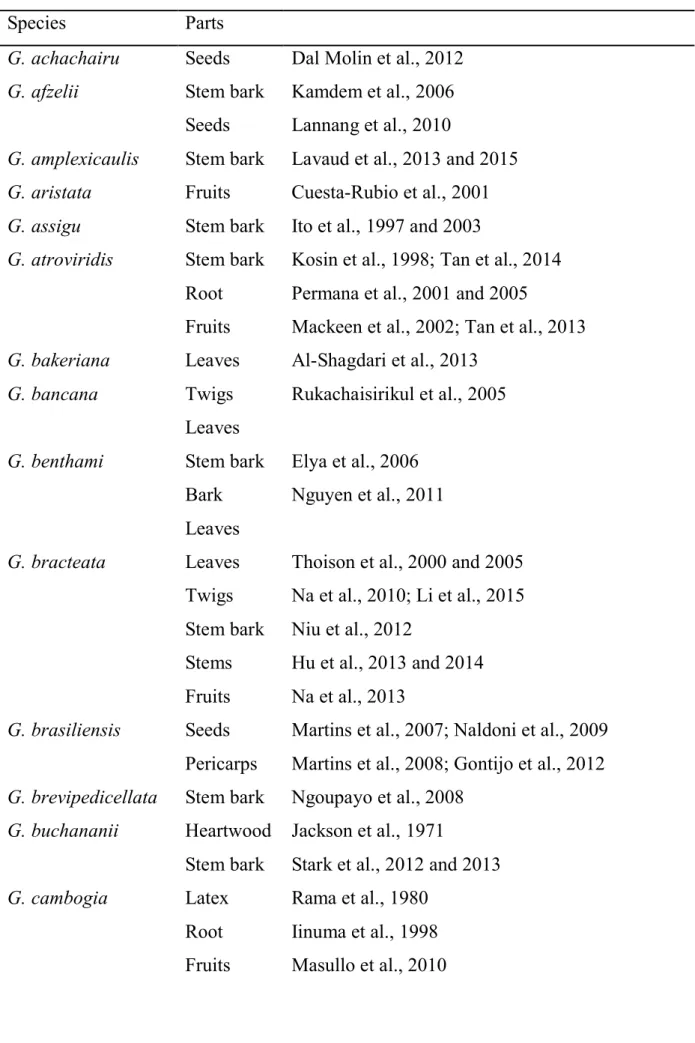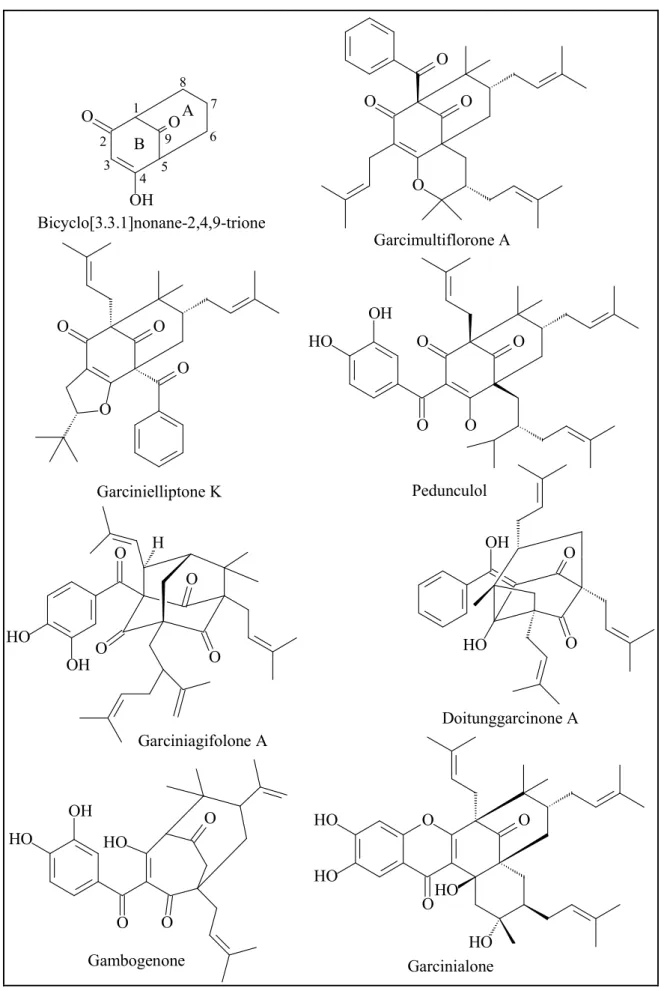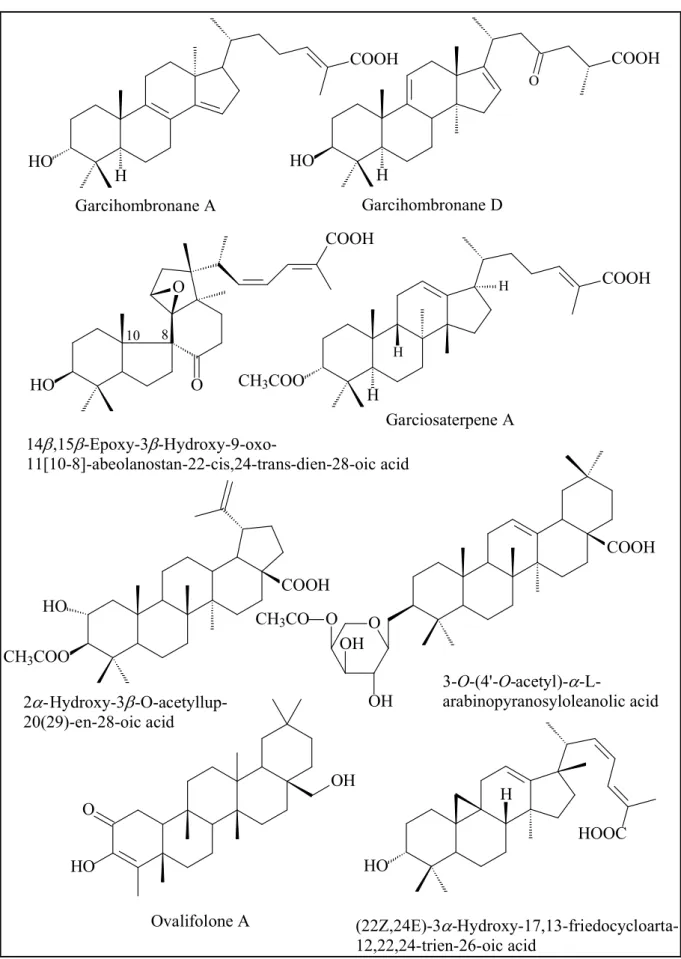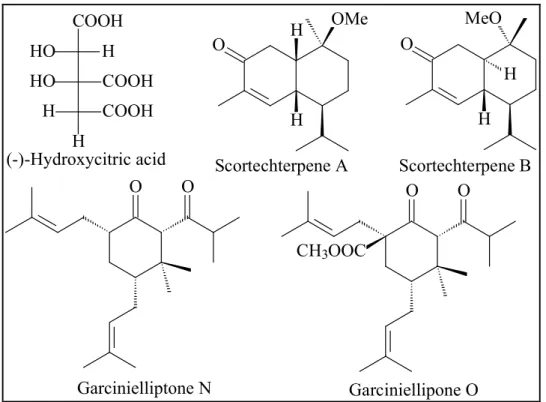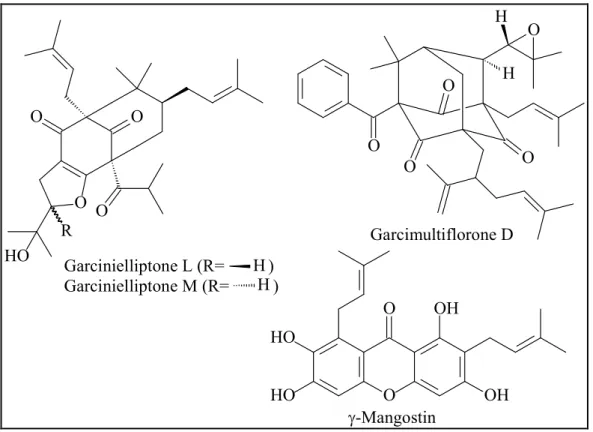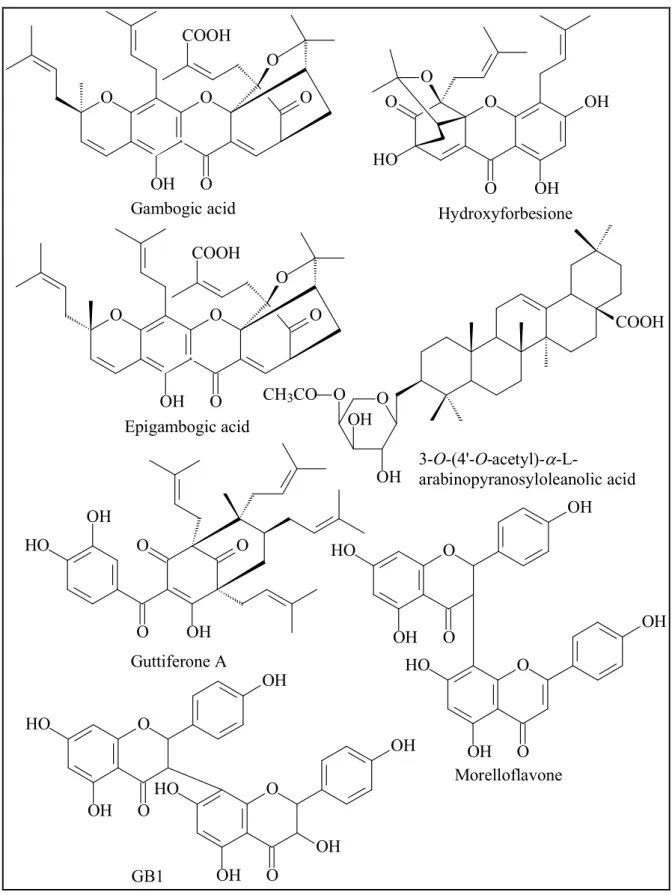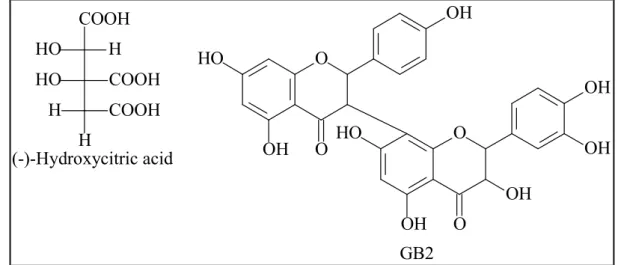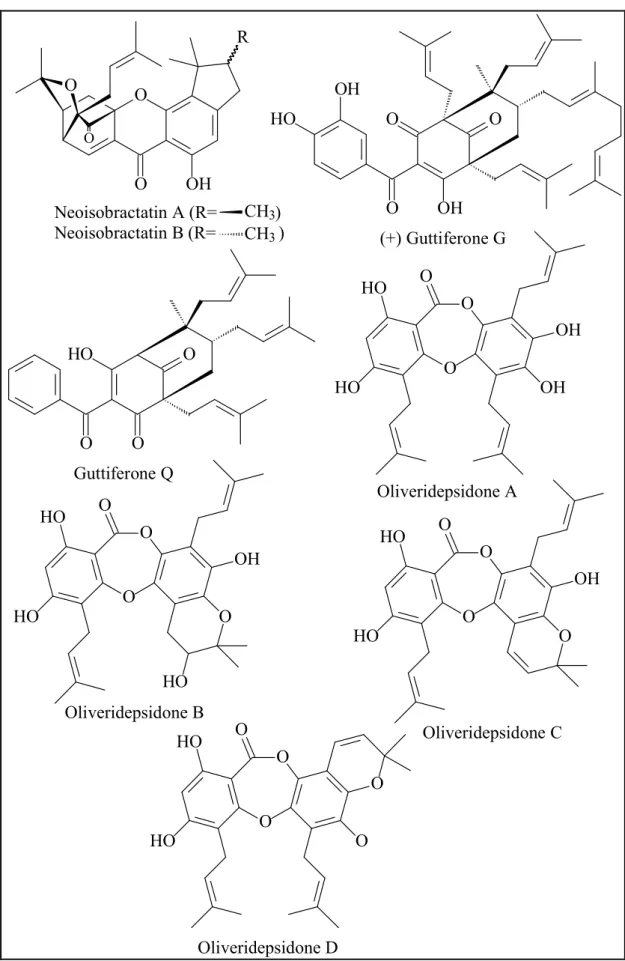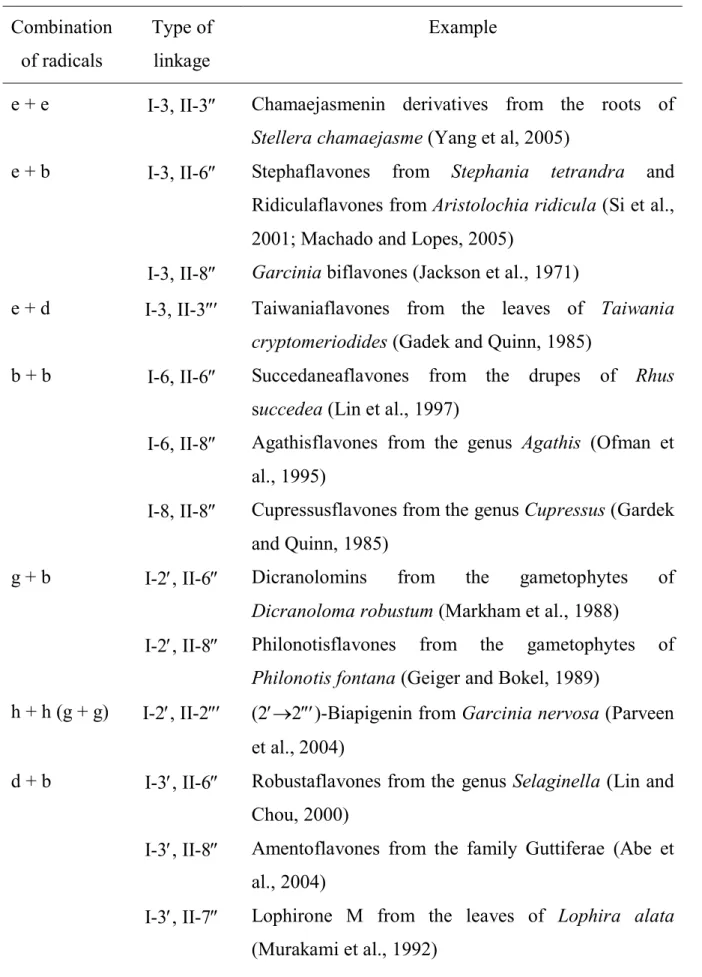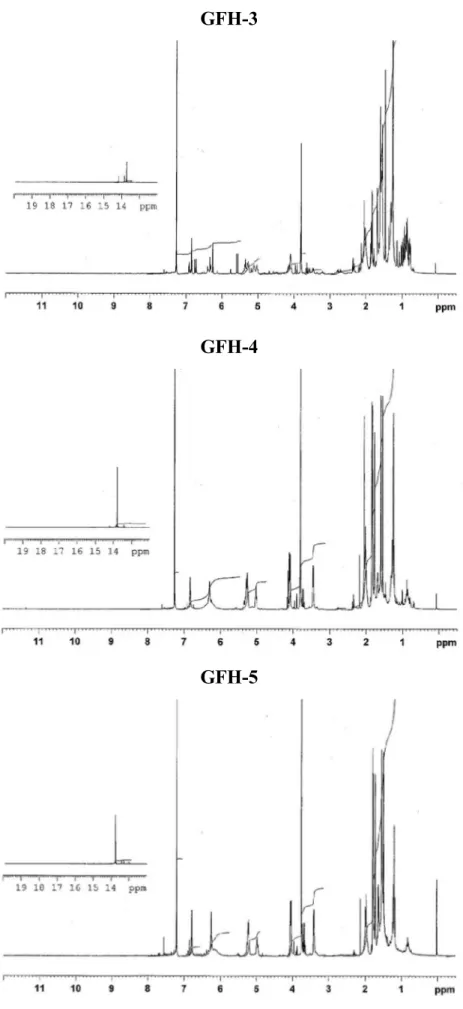A dissertation submitted to the
Faculty of Chemistry and Pharmacy, University of Regensburg for the degree of
Doctor of Natural Sciences (Dr. rer. nat.)
Presented by TRI HIEU NGUYEN
from Ho Chi Minh City University of Science, Vietnam
2015
Pharmacy, University of Regensburg.
This dissertation was submitted on 1st June 2015 The Ph.D. defense was on 23rd June 2015
Board of examiners: PD Dr. Sabine Amslinger (Chairwoman) Prof. Dr. Jörg Heilmann (First-examniner) Prof. Dr. Thomas Schmidt (Second-examiner) Prof. Dr. Gerhard Franz (Third-examiner)
I would like to express my sincere gratitude to my supervisor Prof. Dr. Jörg Heilmann, for accepting me as a member of his group, for providing me helpful working facilities, for his interest in my work as well as his willingness to proofread my thesis.
I offer my deepest gratitude to Assoc. Prof. Dr. Nguyen Dieu Lien Hoa for showing me patience and enthusiasm, for guiding me throughout many years in the field of natural products, as well as being a great source of knowledge.
I would like to thank Assoc. Prof. Dr. Pham Dinh Hung for his willingness to help me when necessary.
I am greatly indebted to my parish-priest Joseph Nguyen Hien Thanh, Dr. Vu Quang Tuyen and M.Ed. Le Minh Ha for supporting and giving me an opportunity to apply the Ph.D. scholarship of KAAD (Bonn, Germany).
My sincere thanks also go to:
- Dr. Guido Jürgenliemk for his kind help in CPC separation.
- Dr. Birgit Kraus for her useful advice in cell culture.
- Dr. Daniel Bücherl for helping me enthusiastically in use of HPLC and connection with the network of the university.
- Dr. Marcel Flemming for his instruction in anti-oxidant assay on RAW cells.
- Dr. Sebastian Schmidt for showing me how to carry out proliferation assay on HMEC-1 cells, as well as for his fruitful discussions in isolation and structural elucidation of natural compounds.
- Gabi Brunner for instructing me in detail about cytotoxicity assay on HeLa cells.
She might be very patient with me.
- My labmate, Stefan Wiesneth for his help in rescue of my user account at the university every time I forgot my passwords, as well as for his tolerance to my clumsiness.
I am grateful to Annette Schramm, Georgine Stühler, Fritz Kastner, Josef Kiermaier and Wolfgang Söllner for measurement of NMR and MS spectra.
I am thankful to the secretary Hedwig Ohli for her kindness and enthusiasm. I wish her all the best in her life.
Thanks go to all my colleagues, staff and students in Dr. Heilamnn’s group for their helps and for the pleasant working atmosphere and enjoyable time we had together. I will never forget our nice memories.
I am very grateful to Katholischer Akademisher Ausländer-Dienst (KAAD, Germany) for providing me a scholarship to complete my Ph.D. project in Regensburg University. I would especially like to thank Dr. Heinrich Geiger and Mrs. Karin Bialas for their kind help to Vietnamese candidates.
I would like to convey my deepest thanks to my family, relatives and friends for understanding, encouraging and supporting me spiritually throughout my life.
Finally, I would like to say with all my faith that I did not obtain all precious helps and supports as mentioned above accidentally but they must have been the blessings of Lord. I could not have completed my Ph.D. project without those valuable helps and supports. With all my heart and soul, I would like to express my greatest gratitude to the Lord for all the blessings I got from Him.
For my father and my late mother, my sisters and brothers
ACKNOWLEDGMENTS
ABBREVIATIONS ...i
SUMMARY ... iv
1. INTRODUCTION ... 1
2. THE GENUS GARCINIA ... 3
2.1. General characters ... 3
2.2. Chemical constituents of Garcinia ... 3
2.2.1. Xanthones ... 12
2.2.1.1. Simple oxygenated xanthones ... 12
2.2.1.2. Prenylated xanthones ... 12
2.2.1.3. Caged xanthones ... 16
2.2.1.4. Bisxanthones ... 16
2.2.2. Biflavonoids ... 18
2.2.3. Benzophenones ... 19
2.2.4. Phloroglucinols ... 22
2.2.5. Depsidones ... 23
2.2.6. Tocotrienols ... 24
2.2.7. Biphenyls ... 25
2.2.8. Triterpenoids ... 25
2.2.9. Other compounds ... 26
2.3. Pharmacological and biological properties of Garcinia ... 30
2.3.1. Anti-oxidant activity ... 31
2.3.2. Antifungal activity ... 31
2.3.3. Antimicrobial activity ... 33
2.3.4. Anti-inflammatory activity ... 35
2.3.5. Anticancer activity ... 36
2.3.6. Antiviral activity ... 36
2.4. Study of the genus Garcinia in Vietnam ... 40
2.5. Garcinia fusca Pierre ... 45
2.5.1. Botanical features and uses in traditional medicine ... 45
2.5.2. Previous chemical and biological investigations ... 45
3. BIOSYNTHESYS OF XANTHONES AND BIFLAVONOIDS ... 47
3.1. Biosynthetic pathway of xanthones ... 47
3.2. Biosynthetic pathway of bioflavonoids ... 59
4. MATERIAL AND METHODS ... 68
4.1. General experimental procedures ... 68
4.2. Extraction, fractionation and isolation... 69
4.2.1. Material of plant ... 69
4.2.2. Extraction of plant material ... 69
4.2.3. Fractionation of crude extracts ... 70
4.2.4. Isolation of substances from fractions ... 70
4.2.4.1. Thin layer chromatography (TLC) ... 71
4.2.4.2. Preparative TLC ... 73
4.2.4.3. Open column chromatography ... 73
4.2.4.4. Flash chromatography ... 74
4.2.4.5. Size-exclusion chromatography... 74
4.2.4.6. Centrifugal partition chromatography ... 75
4.2.4.7. Semi-preparative HPLC ... 76
4.3. Structural elucidation of isolated compounds ... 78
4.3.1. Ultraviolet-visible spectroscopy ... 78
4.3.2. Mass spectrometry ... 79
4.3.3. Nuclear magnetic resonance spectroscopy (NMR) ... 81
4.3.3.1. One dimensional (1D) NMR spectra ... 82
4.3.3.1.1. 1H NMR spectra ... 82
4.3.3.1.2. Proton-decoupled 13C NMR spectra ... 83
4.3.3.2. Two dimensional (2D) NMR spectra ... 83
4.3.3.2.1. COSY spectra ... 83
4.3.3.2.4. NOESY and ROESY spectra ... 84
4.3.4. Optical rotation ... 85
4.4. Biological assays ... 86
4.4.1. Preparation of samples ... 86
4.4.2. Cytotoxicity assay on HeLa cells... 86
4.4.2.1. Cell culture ... 86
4.4.2.2. Cell counting ... 87
4.4.2.3. MTT assay ... 87
4.4.3. Proliferation assay on HMEC-1 ... 88
4.4.3.1. Cell culture ... 88
4.4.3.2. Proliferation assay ... 89
5. RESULTS AND DISCUSSION ... 90
5.1. Experiments ... 90
5.1.1. Fractionation and isolation of the n-hexane extract (GFH) ... 90
5.1.1.1. Isolation from fraction GFH-2 ... 94
5.1.1.2. Isolation of xanthones from fraction GFH-4 ... 94
5.1.1.3. Isolation of compounds from fraction GFH-6 ... 95
5.1.1.4. Isolation of xanthones from fraction GFH-7 ... 97
5.1.2. Fractionation of the ethyl acetate extract and further isolation ... 99
5.1.2.1. Isolation of xanthones from fraction GFE-4 ... 103
5.1.2.2. Isolation of compounds from fraction GFE-6 ... 104
5.2. Structural elucidation of isolated substances ... 105
5.2.1. Structural identification of substances from the n-hexane extract .. 105
5.2.1.1. Compound 21 (fuscaxanthone J) ... 111
5.2.1.2. Compound 20 (fuscaxanthone K) ... 114
5.2.1.3. Compound 19 ((+)-fuscaxanthone I) ... 118
5.2.1.4. Compound 18 (fuscaxanthone L) ... 123
5.2.1.5. Compound 22 (fuscaxanthone M) ... 128
5.2.2. Structural identification of substances from the EtOAc extract ... 133
5.2.2.2. Compound 25 (fuscaxanthone O) ... 140
5.2.2.3. Compound 26 (fuscaxanthone P) ... 144
5.3. Cytotoxicity of new substances ... 148
5.4. Proposed biosynthesis of the new xanthones in G. fusca Pierre ... 150
6. CONCLUSION... 153
REFERENCES ... 154
LIST OF SCHEMES ... 194
LIST OF TABLES ... 195
APPENDICES ... 196
ABBREVIATIONS
AflO
AflY
[]D
Gene encoding the SAM-dependent O-methyltransferase in the Aspergillus species
Gene encoding an enzyme catalyzing the Baeyer-Villiger oxidation in the Aspergillus species
Specific optical rotation brs
BHT
Broad singlet
Butylated hydroxytoluene
CC Column chromatography
CDCl3 Deuterated chloroform C2D6CO
CHS
Deuterated acetone Chalcone synthase
cm Centimetre
COSY Correlated spectroscopy
CPC Centrifugal partition chromatography
Chemical shift
d Doublet
1D One-dimensional
2D Two-dimensional
DCM Dichloromethane
dd Doublet of doublet
DMAPP Dimethylallylpyrophosphate DMSO
DPPH
Dimethylsulphoxide
2,2-Dipheny-1-(2,4,6-trinitrophenyl)hydrazyl EDTA Ethylenediaminetetraacetic acid
EtOAc Ethyl acetate
EtOH Ethanol
FC Flash chromatography
fr. Fraction
FCS FAD
Fetal calf serum
Flavin adenine dinucleotide
GPC Gel permeation chromatography
GPP Geranyldiphosphate
HMBC Heteronuclear multiple bond correlation HMEC-1 Human microvascular endothelial cell line-1 HPLC High performance liquid chromatography HRESI High resolution electrospray ionization HSQC Heteronuclear single quantum coherence IC50 50% Inhibition concentration
J Coupling constant
m MdpB MdpC MdpD MdpJ MdpK MdpL
Multiplet
Gene encoding dehydratase in Aspergillus spp.
Gene encoding phenol reductase in Aspergillus spp.
Gene encoding mono-oxygenase in Aspergillus spp.
Gene encoding glutathione-S-transferase in Aspergillus spp.
Gene encoding oxidoreductase in Aspergillus spp.
Gene encoding Baeyer-Villiger oxidase in Aspergillus spp.
MeCN Acetonitrile
MeOH Methanol
mg Milligram
min Minute
mm Millimetre
µM Micromolar
µl Microliter
MEM Minimum essential medium MHz
MIC
Megahertz
Minimum inhibitory concentration
MS Mass spectrometry
MTT 3-(4,5-dimethylthiazol-2-yl)-2,5-diphenyl tetrazolium bromide m/z Mass-to-charge ratio
n Number
NADPH Nicotinamide adenine dinucleotide phosphate NMR Nuclear magnetic resonance
NOESY Nuclear overhauser enhancement spectroscopy
p.a.
PAL
Pro analysis
Phenylalanine ammonia lyase
PE Petroleum ether
ppm Part per million
PBS Phosphate buffered saline Rf Retardation factor
ROESY Rotating-frame nuclear overhauser effect correlation spectroscopy RP18 Reversed phase C-18
s Singlet
SAM S-Adenosyl methionine SDS Sodium dodecyl sulphate
t Triplet
TLC Thin layer chromatography UV
Ver-A Ver-1 XtpA XtpB XtpC
Ultraviolet
A cytochrome P450 monooxygenase in Aspergillus species An NADH-dependent deoxygenase in Aspergillus species Gene encoding prenyl transferase in Aspergillus spp.
Gene encoding prenyl transferase in Aspergillus spp.
Gene encoding oxidoreductase in Aspergillus spp.
SUMMARY
The Garcinia is a large genus of the family Guttiferae or Clusiaceae, nearly consisting of 450 species. This genus has been of interest due to its therapeutic value in the folk medicine for the treatment of various kinds of diseases such as vomiting, swelling, tapeworms, dysentery, chronic diarrhoea, piles, pains and heart complaints, as well as due to the successive finding of both chemically and biologically interesting compounds (Vo et al., 2012). In Vietnam, around thirty one Garcinia species were found, some of which were phytochemically and biologically investigated (Pham, 1999). For further phytochemical and biological study of the genus Garcinia in Vietnam, Garcinia fusca Pierre was chosen for the investigation.
In this work, the air-dried and powdered bark of G. fusca Pierre (1.95 kg) was successively extracted with n-hexane and ethyl acetate. The NMR-guided fractionation of both the n-hexane and ethyl acetate extracts led to the isolation of thirty one phenolic compounds by means of various chromatographic methods such as TLC, FC, GPC, CPC and semi-preparative HPLC. The structural elucidation was carried out based on data of UV, MS, 1D and 2D NMR spectra together with the optical rotation.
The compounds isolated from the n-hexane extract comprise a tocotrienol, a benzaldehyde derivative and twenty xanthones, five of which (18 – 22) are new and given trivial names fuscaxanthones (+) I, J – M. Meanwhile four biflavonoids and five xanthones were obtained from the ethyl acetate extract, three of which (24 – 26) are new and given trivial names fuscaxanthones N – P, respectively. All the xanthones are prenylated 1,3,6,7-tetrahydroxyxanthone derivatives. Eight new xanthones possess the basic structure of cowanol, which was previously reported from G. cowa (Na Pattalung et al., 1994). However the different features were observed. Fuscaxanthone J (21) might have been O-methylated at 7-OH to form cowanol. In fuscaxanthone (+) I (19), the double-bond at C-17/C-18 of the geranyl group is hydroxylated, whereas the double-bond of the 4-hydroxy-3-methylbut-2-enyl group is epoxylated in fuscaxanthone K (20). In fuscaxanthones N and O (24 and 25), the double-bond at C- 22/C-23 of the geranyl group is hydroxylated and relocated to C-21/C-22 or C-23/C- 24. Meanwhile in fuscaxanthone L and P (18 and 26), the geranyl group is cyclized to give a monoterpenoid substitute with a C6 ring. To the best of our knowledge,
parvixanthone I, which was reported from G. parvifolia, was the only xanthone with such a substitute (Xu et al., 2001). Fuscaxanthone M (22) is a dimer of cowanol, which is combined by an unusual C-O-C linkage.
The new xanthones and cowanol were tested for cytotoxicity on HeLa cells to establish a preliminary basis of a structure – activity relationship. The results showed that these xanthones had cytotoxic effect with the IC50 values in the range of 19.1 – 45.9 µM, except that compounds 20 and 22 were inactive. The modification of the geranyl group or the 4-hydroxy-3-methylbut-2-enyl group brought about a decrease or loss of activity compared with cowanol. Moreover griffipavixanthone, which was previously isolated from G. griffithii, G. pavifolia and G.oblongifolia (Xu et al., 1998;
Shi et al., 2014), exhibited a high cytotoxicity against HeLa cells with an IC50 value of 7.9 0.7 µM. This bixanthone was further evaluated for anti-angiogenic activity by in vitro proliferation assay on HMEC-1 cell line and it showed a greatly strong anti- proliferative effect with an IC50 value of 0.15 0.0085 µM after 72 h incubation, which indicated that griffipavixanthone is a potential anti-angiogenic agent which should be further demonstrated in vivo and in further molecular assays.
The results of this work together with those previously reported (Ito et al., 2003;
Nontakham et al., 2014) revealed that Garcinia fusca Pierre is a rich source of tetraoxygenated xanthones and biflavonoids. The cytotoxicity of those xanthones suggested that the bark of this plant may have an anti-tumor effect, which should be further studied for use in medicine.
1. INTRODUCTION
Vietnam is situated along the eastern coast of the Indochina Peninsula in Southeast Asia and covers an area of 329,500 square kilometres. The country is bordered to the north by China, to the west by Laos and Cambodia and to the east by South China Sea (known in Vietnam as the East Sea). As a result of the warm and humid tropical climate, approximately 39% of Vietnam territory is under forest cover with around 13,000 species of vascular plants, over 8,000 of which have been identified to date (Sterling and Hurley, 2005; Queiroz et al., 2013). Early on Vietnamese people discovered pharmaceutical properties of some plants and used them as medical remedies to prevent or treat some diseases such as eating ginger to treat cold and flu, drinking the water extract of Artemisia as an anti-malaria agent and chewing betel to prevent tooth decay. These formed the basis of Vietnamese traditional medicine.
During the thousand years of Chinese domination, Vietnamese traditional medicine was deeply influenced by Chinese traditional medicine. In the nineteenth century, Western medical practices were introduced to Vietnam with the arrival of the French (Ladinsky et al., 1987). Nowadays Vietnamese medicine is a harmonious merging of Chinese, Vietnamese and Western medicinal system, in which traditional medicine has an important role in promoting the health of Vietnamese people, especially in primary health care at the commune level and the treatment of chronic illnesses such as AIDS and cancer which seem to be increasing. The statistics of the Vietnam Ministry of Health showed that about 30% of patients annually received the treatment with traditional medicines (WHO, 2005). Vietnamese traditional medical remedies are mainly based on medicinal plants. According to a report of the Vietnam Ministry of Health in 2014, 3,948 of 10,386 identified species have been known as medicinal plants, a large number of which have not been phytochemically investigated to improve use value. Moreover pharmaceutical properties of the remaining species have not determined yet. The report also showed that many valuable and rare medicinal plants are in the risk of extinction because of deforestation and uncontrolled exploitation of medicinal sources (The Vietnam Ministry of Health, 2014).
The Guttiferae or Clusiaceae is a family of plants including about 37 genera and 1610 species of trees and shrubs. This family is mainly tropical (Gustafsson et al., 2002). In Vietnam, there are around sixty five species of six genera comprising Calophyllum, Cratoxylum, Garcinia, Mammea, Mesua and Ochrocapus. Some species are used in folk medicine to treat various diseases such as dysentery, diarrhoea, coughs, fever, scabies, burns, menstrual disturbances and ulcer; whilst pharmaceutical properties of the remaining species have not been known (Vo, 1997; Pham, 1999).
Though many species of the family Guttiferae have been phytochemically and biologically investigated all over the world, approximately twenty species collected in Vietnam have been reported so far. In order to contribute to phytochemical and biological study of the family Guttiferae in Vietnam, we have investigated the species Garcinia fusca Pierre collected in south Vietnam. The aim of this work was the isolation of natural compounds to characterize the phytochemical profile in detail and to provide possible new structures for drug discovery whereby that helps to improve use value of this species in the traditional medicine. Moreover, that also supplies phytochemical database of this species for classification and conservation of medicinal plants in Vietnam. The results of the phytochemical and biological investigation on the n-hexane and ethyl acetate extracts of G. fusca Pierre are presented in this thesis.
2. THE GENUS GARCINIA
2.1. General characters
The Garcinia is a large genus of the family Guttiferae (Clusiaceae), comprising around 450 species of tropical trees and shrubs with yellow resin or latex, mostly native to the Old World (tropical and South Africa, Madagascar, south-eastern Asia, north-eastern Australia and western Polynesia), with a few species in the tropical regions of the Americas. Various Asiatic species are used as a cathartic or stimulant, dye or artist’s pigment. Many species are important timber resources used for construction and furniture. In Vietnam there are about thirty one species (Pham, 1999).
The members of the genus are various considerably in size and form but generally have opposite leaves (occasionally whorled), entire (untoothed or lobed), which are often evergreen, often thick and leathery but occasionally papery, with prominent secondary veins. The flowers, often fragrant, commonly have four or five parts, and occur in singly or in clusters of up to 5, which may be terminal (at branch tips) or axillary (where leaf meets stem). The fruit is a berry with a thin to leathery skin and one to five seeds (or more) embedded in a fleshy or pulpy, often edible, aril. The delicious mangosteen which is produced by G. mangostana, has been called “Queen of fruits” (Bailey and Bailey, 1976; Xiwen et al., 2007).
2.2. Chemical constituents of Garcinia
The genus Garcinia consists of many medicinal plants containing potential therapeutic agents which have been globally used in folk medicine. Those have attracted researchers to pharmaceutical and phytochemical investigations of species from the genus. To the best of our knowledge, approximately one hundred and seven species of the genus have been phytochemically investigated so far. A variety of plant parts were studied such as latex, resin, leaves, bark, root, stems, twigs, heartwood, branches, fruits, pericarps, seeds and flowers, see Table 1. These investigations revealed that the genus Garcinia produces different types of secondary metabolites including xanthones, biflavonoids, benzophenones, acylphloroglucinols, triterpenoids, depsidones, tocotrienols and biphenyls.
Table 1. Garcinia species which have been phytochemically investigated to date
Species Parts
G. achachairu Seeds Dal Molin et al., 2012 G. afzelii Stem bark
Seeds
Kamdem et al., 2006 Lannang et al., 2010
G. amplexicaulis Stem bark Lavaud et al., 2013 and 2015 G. aristata Fruits Cuesta-Rubio et al., 2001 G. assigu Stem bark Ito et al., 1997 and 2003 G. atroviridis Stem bark
Root Fruits
Kosin et al., 1998; Tan et al., 2014 Permana et al., 2001 and 2005
Mackeen et al., 2002; Tan et al., 2013 G. bakeriana Leaves Al-Shagdari et al., 2013
G. bancana Twigs
Leaves
Rukachaisirikul et al., 2005
G. benthami Stem bark Bark Leaves
Elya et al., 2006 Nguyen et al., 2011
G. bracteata Leaves Twigs Stem bark Stems Fruits
Thoison et al., 2000 and 2005 Na et al., 2010; Li et al., 2015 Niu et al., 2012
Hu et al., 2013 and 2014 Na et al., 2013
G. brasiliensis Seeds Pericarps
Martins et al., 2007; Naldoni et al., 2009 Martins et al., 2008; Gontijo et al., 2012 G. brevipedicellata Stem bark Ngoupayo et al., 2008
G. buchananii Heartwood Stem bark
Jackson et al., 1971
Stark et al., 2012 and 2013 G. cambogia Latex
Root Fruits
Rama et al., 1980 Iinuma et al., 1998 Masullo et al., 2010
Table 1. (continued)
G. cantleyana Trunk bark Twigs
Shadid et al., 2007 Jantan et al., 2012 G. celebica Leaves Elfita et al., 2009
G. chapelieri Bark Rambeloson et al., 2014
G. cochinchinensis Bark Nguyen et al., 2011; Trinh et al., 2013 G. conrauana Bark
Heartwood Seeds Leaves
Hussain and Waterman, 1982
G. cornea Stem bark Elfita et al., 2009
G. cowa Latex
Fruits Stems Stem bark
Na Pattalung et al., 1994; Mahabusarakam et al., 2005 Panthong et al., 2006; Sriyatep et al., 2014
Shen et al., 2007; Siridechakorn et al., 2012
G. cuneifolia Stem bark Ea et al., 2003 G. cymosa Stem bark Elfita et al., 2009
G. densivenia Stem bark Waterman and Crichton, 1980 G. dioica Bark Iinuma et al., 1996
G. dulcis Branches
Root Bark Leaves Fruits Flowers Seeds
Harrison et al., 1994 Iinuma et al., 1996 Ito et al., 1997 Kosela et al., 2000 Deachathai et al., 2005 Deachathai et al., 2006 Deachathai et al., 2008 G. echinocarpa Bark Bandaranayake et al., 1975 G. edulis
G. esculenta
Root bark Twigs
Magadula, 2010 Zhu, et al., 2014 G. eugeniifolia Heartwood Jackson et al., 1971
Table 1. (continued)
G. ferrea
Stem bark Bark
Hartati et al., 2008 Bui et al., 2014 G. forbesii Branches
Twigs
Harrison et al., 1992
G. fusca Stem bark
Root
Ito et al., 2003
Nontakham et al., 2014 G. gardneriana Leaves
Bark Seeds
Castardo et al., 2008 Otuki et al., 2011
G. gaudichaudii Leaves Bark
Cao et al., 1998 Xu et al., 2000
G. gerrardii Root bark Sordat-Diserens et al., 1989 G. griffithii Stem bark
Leaves Bark
Elfita et al., 2009; Nilar et al., 2005 Alkadi et al., 2013
Xu et al., 1998 G. hanburyi Latex
Fruits Leaves Twigs
Asano et al., 1996; Tao et al., 2009 Reutrakul et al., 2007
Reutrakul, 2010
G. hombroniana Pericarps Leaves Twigs Bark
Rukachaisirikul et al., 2000 Rukachaisirikul et al., 2005 Klaiklay et al., 2013
Jamila et al., 2014
G. huillensis Stem bark Bakana et al., 1987; Dibwe et al., 2012 G. humilis Bark Herath et al., 2005; Haase, 2011
G. indica Seeds
Leaves
Badami and Desai, 1968 Badami and Razdan, 1972 Heartwood
Fruits
Cotterill et al., 1977
Krishnamurthy et al., 1981 and 1982
Table 1. (continued)
G. intermedia
Stem bark Leaves
Lakshmi et al., 2002 Abe et al., 2004
G. kola Fruits
Seeds Bark Root Stems Mesocarp
Hussain et al., 1982 Iwu, 1985
Kabangu et al., 1987
Iwu et al., 1990; Niwa et al., 1994 Terashima et al., 1999a and 1999b Morabandza et al., 2013
G. lateriflora Stem bark Kosela et al., 1999; Ren et al., 2010 G. lancilimba Stem bark Yang et al., 2007; Han et al., 2008 G. latissima Bark Ito et al., 1997
G. linii Root Chen et al., 2004 and 2006 G. livingstonei Heartwood
Root bark Leaves Fruits
Pelter et al., 1971
Sordat-Diserens et al., 1990 and 1992 Kaikabo et al., 2009
Yang et al., 2010
G. lucida Bark
Stem bark
Nyemba et al., 1990 Fotie et al., 2007 G. macrophylla Leaves
Flowers Twigs
Andrade et al., 2007
Williams et al., 2003 G. madruno Aerial Osorio et al., 2013 G. maingayii Stem bark Hartati et al., 2007
G. malaccensis Stem bark Taher et al., 2012; Alkadi et al., 2013 G. mangostana Fruits
Leaves Pericarps Heartwood Root bark
Govindachari et al. 1971; Suksamrarn et al., 2006 Parveen et al., 1990 and 1991
Sen et al., 1982; Suksamrarn et al., 2002 Nilar and Harrison, 2002
Ea et al., 2006
Table 1. (continued)
G. mannii
Stem bark Bark Heartwood Seeds Leaves
Ea et al, 2008; Han et al., 2009 Crichton and Water, 1979 Hussain and Waterman, 1982
G. merguensis Bark Wood Twigs
Nguyen et al., 2003 Kijjoa et al., 2008 Trisuwan et al., 2013 G. multiflora Heartwood
Stems Fruits Twigs Stem bark Leaves
Chen et al., 1975 Chiang et al., 2003 Chen et al., 2008 Liu et al., 2010 Jing et al., 2013 Jiang et al., 2014 G. myrtifolia Bark Spino et al., 1995 G. neglecta Leaves Ito et al., 2001 G. nervosa Stem bark
Leaves
Ampofo and Waterman, 1986 Babu et al., 1988; Ilyas et al., 1994 G. nigrolineata Bark
Leaves Twigs
Rukachaisirikul et al., 2003 Rukachaisirikul et al., 2003 Rukachaisirikul et al., 2005 G. nobilis
G. nujiangensis
Stem bark Twigs Twigs
Fouotsa et al., 2012 Fouotsa et al., 2014 Tang et al., 2015 G. oblongifolia Bark
Stems Leaves Bark
Hamed et al., 2006 Wu et al., 2008 Zhang et al., 2014 Feng et al., 2014
G. oligantha Stems Gao et al., 2013; Wu et al., 2013
Table 1. (continued) G. oliveri
G. opaca
Bark Leaves Bark
Ha et al., 2009 and 2012 Goh et al., 1992
Mori et al., 2014 G. ovalifolia Stem bark
Leaves
Waterman and Crichton, 1980; Lannang et al., 2013 Gustafson et al., 1992
G. parvifolia Leaves Bark Stem bark Twigs
Xu et al., 2000 Xu et al., 2001
Kardono et al., 2006; Syamsudin et al., 2013 Rukachaisirikul et al., 2006
G. paucinervis Leaves Stem bark Stems
Gao et al., 2010; Wu et al., 2013 Fan et al., 2012
Hu et al., 2014 G. penangiana Leaves Jabit et al., 2007 G. penduculata Heartwood
Pericarps Bark
Rao et al., 1974 Sahu et al., 1989 Vo et al., 2012 G. polyantha Stem bark
Wood Root bark Leaves
Lannang et al., 2005 Louh et al., 2008 Lannang et al., 2008 Lannang et al., 2014 G. porrecta Stem bark Kardono et al., 2006 G. prainiana Leaves
Twigs
Klaiklay et al., 2011; Mawa and Said, 2012 Susanti et al., 2013
G. preussii Leaves Messi et al., 2012 G. propinqua Twigs Tantapakul et al., 2012 G. pseudoguttifera Heartwood Ali et al., 2000
G. puat Leaves Ito et al., 2001 G. punctata Stem bark Ngameni et al., 2014 G. purpurea Pericarp Iinuma et al., 1996
Table 1. (continued)
G. pyrifera Stem bark Fruits
Ampofo and Waterman, 1986 Roux et al., 2000
G. quadrifaria Stem bark Waterman and Hussain, 1982 G. quaesita Bark Gunatilaka et al., 1984
G. rigida Leaves Elya et al., 2006 and 2011 G. scortechinii Twigs
Latex Stem bark Fruits
Rukachaisirikul et al., 2000 Rukachaisirikul et al., 2003 Rukachaisirikul et al., 2005 Sukpondma et al., 2005 G. semseii Stem bark
Pericarps
Magadula et al., 2008 Magadula et al., 2012 G. shomburgkiana Bark
Wood Stems
Vo et al., 2012
Mungmee et al., 2013 Ito et al., 2013
G. smeathmannii Stem bark Root bark
Komguem et al., 2005; Kuete et al., 2007 Lannang et al., 2006
G. solomonensis Stem bark Carroll et al., 2009
G. speciosa Bark
Trunk bark
Vieira et al., 2004
Rukachaisirikul et al., 2003
G. spicata Bark
Fruit Leaves
Konoshima et al., 1970 Lyles et al., 2014 Gunatilaka et al., 1984 G. subelliptica Heartwood
Root bark Wood Seeds Stem bark Fruits Leaves
Fukuyama et al., 1991 Iinuma et al., 1995 Fukuayama et al., 1998 Weng et al., 2003 and 2004 Abe et al., 2003
Zhang et al., 2010 Ito et al., 2013
Table 1. (continued)
G. succifolia Wood Duangsrisai et al., 2014 G. staudtii Stem bark Waterman and Hussain, 1982 G. talboti Root Joshi et al., 1970
G. terpnophylla Bark Wood
Bandaranayake et al., 1975
G. tetralata Stem bark Branches Leaves
Wang et al., 2008; Guo et al., 2011 Na and Xu, 2010
G. tetranda Wood Purwaningsih and Ersam, 2007 G. thwaitesii Bark
Timber
Gunatilaka et al., 1983
G. vieillardii Stem bark Hay et al., 2004 and 2008
G. vilersiana Bark Nguyen et al., 1999; Bui et al., 2012 G. virgata Stem bark Merza et al., 2004 and 2006
G. volkensii Heartwood Bark
Herbin et al., 1970 Magadula et al., 2014 G. xanthochymus Fruits
Bark Stem bark Twigs
Karanjgoakar et al., 1973; Baggett et al., 2005 Chen et al., 2008 and 2010
Ji et al., 2012
Trisuwan et al., 2014 G. xipshuanbannaensis Fruits
Leaves Twigs
Shen et al., 2006 Na and Xu, 2010
Han et al., 2008; Na and Xu, 2009
2.2.1. Xanthones
The latex or resin of Garcinia species is commonly yellow because of the presence of xanthone derivatives. Xanthones have been widely found in all species of this genus including simple oxygenated xanthones, prenylated xanthones, caged xanthones and bisxanthones.
2.2.1.1. Simple oxygenated xanthones
These compounds can be di-, tri-, tetra- or penta-oxygenated xanthones with simple substituents such as hydroxyl, methoxyl and methyl groups (see Figure 1). Two xanthones, 1,5- and 1,7-dihydroxyxanthones are simple di-oxygenated xanthones found extensively in many species (Bennett and Lee, 1989). Simple tri-oxygenated compounds as 1,3,5-trihydroxyxanthone and 1,5-dihydroxy-2-methoxyxanthone were isolated from G. xanthochymus (Baslas, 1979). Three xanthones, 1,3,5,7-, 1,3,6,7- tetrahydroxyxanthones and 1,2-dihyroxy-5,6-dimethoxyxanthone, which were reported from G. penduculata and G. subelliptica, are examples for simple tetra-oxygenated xanthones (Rao et al., 1974; Minami et al., 1995). Simple penta-oxygenated xanthones are rarely found in the genus, whereas some were isolated from the genus Calophyllum (Guttiferae). Three xanthones, 1,3,4,5,8-pentahydroxyxanthone, 1,3,8-trihydroxy-4,6- dimethoxyxanthone and 1,3,7-trihydroxy-4,6-dimethoxyxanthone, are simple penta- hydroxyxanthones identified from two species G. tetranda and G. hombroniana (Purwaningsih and Ersam, 2007; Klaiklay et al., 2013).
2.2.1.2. Prenylated xanthones
Prenylated xanthones are di-, tri-, tetra- and penta-oxigenated xanthones, whose the aromatic ring system is substituted by prenyl groups such as isoprenyl, 1,1- dimethylprop-2-enyl, geranyl and farnesyl (see Figure 2). These groups can be cyclized with adjacent hydroxyl groups at the ortho-position to give tetra- or penta- cyclic xanthones with furano- or pyrano rings, respectively. A xanthone can be substituted by one, two or three prenyl groups. Natural xanthones with more than three prenyl groups have not yet been found up to date. A large number of prenylated tri- and tetra-oxygenated xanthones have been reported from the genus. Prenylated penta-
oxygenated xanthones are rare. 1,7-Dihydroxy-3-methoxy-2-(3-methylbut-2- enyl)xanthone, isocowanol and dulciol C, three xanthones from G. mangostana, G.
pyrifera and G. dulcis, are three xanthones substituted by one, two and three prenyl groups (Mahabusarakam et al., 1987; Ampofo and Waterman, 1986; Iinuma et al., 1996). Garcigerrin A, a tri-oxygenated xanthone with a pyrano ring from G. gerrardii and rheediaxanthone B, a tetra-oxygenated xanthone with a furano ring from G.
polyantha, are two examples of tetracyclic xanthones (Ampofo and Waterman, 1986;
Sordat-Diserens et al., 1989). Subelliptenone C from G. subelliptica is a tetra-cyclic xanthone with a furo ring (Iinuma et al., 1995). BR-xanthone A, a xanthone from G.
mangostana and 1,5-dihydroxy-6,6-dimethylpyrano(2,3:6,7)-4,4,5- trimethylfurano(2,3:3,4)-2-(3-methylbut-2-enyl)xanthone, a xanthone from G.
opaca, are representative of penta-cyclic xanthones (Balasubramanian and Rajagopalan, 1988; Goh et al., 1992). 5-Farnesyltoxyloxanthone, a tetraoxygenated xanthone isolated from G. merguensis, is a rare xanthone with a farnesyl group (Kijjoa et al., 2008).
O
O OH
OH
O
O OH
HO
O
O OH
OH OH
1,5-Dihydroxyxanthone 1,7-Dihydroxyxanthone 1,3,5-Trihydroxyxanthone
O
O OH
OH OH
HO
O
O OH
OH HO
HO
O
O OH
OH OH
OH OH
1,3,6,7-Tetrahydroxyxanthone 1,3,5,7-Tetrahydroxyxanthone 1,3,4,5,8-Pentahydroxyxanthone
O
O OH
OMe
OH O
O OH
OH
MeO
OMe
1,5-Dihydroxy-2-methoxyxanthone 1,2-Dihydroxy-5,6-dimethoxyxanthone
O
O OH
OH OMe MeO
OH
O
O OH
OH OMe HO
MeO
1,3,7-Trihydroxy-4,6-dimethoxyxanthone 1,3,8-Trihydroxy-4,6-dimethoxyxanthone Figure 1. Simple xanthones from some Garcinia species
O
OH O
OMe HO
1,7-Dihydroxy-3-methoxy-2-
(3-methylbut-2-enyl)xanthone O
O OH
OH HO
OH MeO
O
O OH
OH HO
OH
HO
Isocowanol
Dulciol C
O
OH O
OH O
HO HO
O
OH O
OH HO O
Garcigerrin A
Rheediaxanthone B
BR-xanthone A
O
OH O
OH OH
O
Subelliptenone C
O
OH O
OH
O O
1,5-Dihydroxy-6,6-dimethylpyrano(2,3:6,7)-4'',4'',5''- trimethylfurano(2'',3'':3,4)-2-(3-methylbut-2-enyl)xanthone
O O
O OH
OH HO
5-Farnesyltoxyloxanthone O
OH O
O HO
O
Figure 2. Prenylated xanthones from some Garcinia species
2.2.1.3. Caged xanthones
These compounds are polyprenylated xanthones, in which the ring B is converted into an unusual ring, 4-oxa-tricyclo[4.3.1.03,7]dec-2-one (caged) scaffold (Ollis et al., 1965). This motif can be further modified with various substituents on the aromatic ring A and can also be oxidized to form a wide range of compounds with interesting structures, see Figure 3. Caged xanthones have been restrictively found in some species of the genus Garcinia, especially G. hanburyi. Over one hundred compounds have been identified from the genus. Morellin, a caged xanthone from G. morella, was first reported in 1937 (Rao, 1937). Gambogellic acid, one of caged xanthones isolated from G. hanburyi, has a polycyclic structure (Asano et al., 1996). Although the majority of caged xanthones possess the general motif, a few compounds have alternative structures. For example, 6-O-methylneobractatin identified from G.
bracteata, contains the neo-motif (Thoison et al., 2000). Lateriflorone isolated from G.
lateriflora, has a spiroxalactone core by oxidation of the ring C (Kosela et al., 1999), whilst the ring B in the structure of scortechinone K, one of caged xanthones from G.
scortechinii, undergoes ring-opening oxidation (Rukachaisirikul et al., 2003).
2.2.1.4. Bisxanthones
Bisxanthones are dimeric xanthones, which have been found in some species of the family Guttiferae. They are formed from prenylated monomeric xanthones by ring- closure coupling through side-chains, see Figure 4. Garcilivins A-C, which was isolated from the bark of the of roots G. livingstonei, have been reported for the first time from the genus. These compounds are dimerics linked via a 6-membered ring, which is formally derived from a Diels-Alder-type reaction between two isoprenyl units. (Sordat-Diserens et al., 1992). Bigarcinenone A from the bark of G.
xanthochymus is a dimer linked via a 5-membered ring like cratoxyxanthone. A biosynthetic pathway of the latter one was proposed to involve the coupling of two xanthone radicals, see Scheme 11 (Zhong et al., 2008). Bigarcinenone B, which was also obtained from G. xanthochymus, is a bisxanthone that is connected via a 6- and 6- membered ring system (Chen et al., 2011).
O O
O O
A B
C
O O
OH O
O O HOC
Morellin 6-O-Methylneobractatin
O
OH O
O O
O
O O
OH O
O O HOOC
Gabogellic acid General motif of caged xanthones
O O
O
O O O
O O
OH Lateriflorone
O
OH O
O HOOC
O
OCH3
O O
Scortechinone K Figure 3. Caged xanthones from some Garcinia species
O
O OH
OH OH
O
O OH
R OH
OH Garcilivin A (R = )H Garcilivin C (R = )H
O
O OH
OH OH O
O
O OH HO
Garcilivin B
O
O OH
OH OH
O
O O
HO
OH
OH OH H
H
O
O OH
OH O
O
OH HO
HO HO OH
Bigarcinenone B
Bigarcinenone A Figure 4. Bisxanthones from some Garcinia species
2.2.2. Biflavonoids
The genus Garcinia is shown to be a source of biflavonoids. To the best of our knowledge, about one hundred biflavonoids have been identified from this genus to date. The majority of these compounds are dimers of two flavanones, two flavones, between a flavanone and a flavone or a flavanonol, which are linked at the positions C- 3 and C-8 or C-3 and C-8. There are four main groups of Garcinia biflavonoids:
GB-1 type with a flavanone-(3-8)-flavanonol system, GB-1a type with a flavanone-
(3-8)-flavanone system, morelloflavone type with a flavanone-(3-8)-flavone system and amentoflavone type with a flavone-(3-8)-flavone system (Ferreira et al., 2012;
Ito et al., 2013). Beside these four types, some biflavonoids have alternative structures.
For instance, lateriflavone with the 6-8 linkage has been isolated from G. lateriflora, whereas (22)-biflavonol from G. nervosa has a rare linkage between C-2 and C- 2, see Figure 5 (Parveen et al., 1994; Ren et al., 2010).
2.2.3. Benzophenones
Benzophenones from Garcinia comprise simple benzophenones and polyprenylated benzophenones, in which the aromatic ring A can undergo oxidation, prenylation and cyclization to form polycyclic benzophenones with a bicyclo[3.3.1]nonane-2,4,9- trione skeleton (Zhang et al., 2010). These polycyclic benzophenones are divided into three types corresponding to the position of the benzoyl group. Type A includes compounds with the benzoyl group at C-1, for example garcimultiflorone A from G.
multiflora (Chen et al., 2009). Type B, with the benzoyl group at C-3 such as pedunculol from G. pendunculata, was widely found in the genus (Sahu et al., 1989).
Garcinielliptone K, which was obtained from G. subelliptica, is representative of type C with the benzoyl group at C-5 (Weng et al., 2004). Cyclization involving the β- diketone and olefinic groups in polyprenylated compounds led to formation of interesting adamantanyl benzophenones such as garciniagifolone A from G.
oblongifolia (Shan et al., 2012).. Additionally in some cases, the ring B can be modified into a bicyclo[3.3.2]decane-2,4,10-trione skeleton such as gambogenone reported from G. xanthochymus or can undergo intramolecular oxidative coupling between the enol and the aromatic ring B to form corresponding polycyclic xanthone derivatives, for examples garcinialone obtained from G. multiflora (Baggett et al., 2005; Chien et al., 2008). Doitunggarcinone B, which was isolated from G. propinqua, is an unusually rearranged benzophenone, see Figure 6 (Tantapakul et al., 2012).
O HO
OH O
OH
O HO
OH O
OH
OH
O HO
OH O
OH
O HO
OH O
OH
O HO
OH O
OH
O HO
OH O
OH
O HO
OH O
OH
O HO
OH O
OH
O HO
OH O
OH
O HO
OH O
OH
O HO
OH O
OH
OH
HO
O
OH
OH HO
O
3
8'' 3' 8''
6
8''
2'
2'''
GB-1 GB-1a
Morelloflavone
Amentoflavone
Lateriflavone
(I-2', II-2''')-Biapigenin
Figure 5. Biflavonoids from some Garcinia species
O
OH O
1 2
3
4 5 6 7 8
9
O
O O
O
Bicyclo[3.3.1]nonane-2,4,9-trione
Garcimultiflorone A
O
O O OH
HO O
Pedunculol O
O
O O
Garcinielliptone K B
A
O O
H
HO
OH O
O
O
O O OH
HO HO
Garciniagifolone A
Gambogenone
O
HO O O
HO HO HO
Garcinialone
Doitunggarcinone A O
O OH
HO
Figure 6. Benzophenones from some Garcinia species
2.2.4. Phloroglucinols
Phloroglucinol derivatives reported in the genus include simple phloroglucinols and complex compounds with an oxidized and polyprenylated nucleus or a bicyclo[3.3.1]nonane-1,3,9-trione skeleton. Parvifoliol A is one of simple phloroglucinols isolated from G. parvifolia (Rukachaisirikul et al., 2006).
Garcinielliptone HB is one of seven polyprenylated phloroglucinols identified from G.
subelliptica, whilst garcicowin A from G. cowa is a phloroglucinol derivative with the bicycle[3.3.1]nonane-1,3,9-trione core (Lu et al., 2008; Xu et al., 2010).
Garcinielliptone HF, which was also obtained from G. subelliptica, is a phloroglucinol with an unprecedented skeleton, see Figure 7 (Wu et al., 2008).
OH
MeO OMe
HO O
Parvifoliol A
O
OMe O O
HO
O
O HO
OH OH
O H
OH O
Garcinielliptone HF Garcicowin A
Garcinielliptone HB
O
O O
Figure 7. Phloroglucinol derivatives from some Garcinia species
2.2.5. Depsidones
Depsidones are polyphenolic compounds containing the 11H-dibenzo[b,e][1,4]- dioxepin-11-one system. These compounds were mainly found in lichens, which usually provide polyketide-derived natural products. However a substantial number of depsidones were reported from the genus Garcinia, which is well known as a rich source of shikimate-derived aromatic compounds. Depsidones from the genus are commonly substituted with hydroxyl, methoxyl, isoprenyl and geranyl groups. For instance, garcidepsidone A, one of four prenylated depsidones, was isolated from G.
parvifolia (Xu et al., 2000). Prenyl side-chains can be cyclized with hydroxyl groups at the position ortho to give tetra- and penta-cyclic compounds such as garcinisidone B and C, a tetracyclic depsidone and a penta-cyclic depsidone, respectively, were identified from G. neglecta, see Figure 8 (Ito et al., 2001).
O O O
O O HO O
HO
OH OH
O O HO O
OMe OH O
O HO O
O
O 11H-dibenzo[b,e][1,4]-dioxepin-11-one
Garcidepsidone A
Garcinisidone C Garcinisidone B
Figure 8. Depsidones from some Garcinia species
2.2.6. Tocotrienols
Tocotrienol derivatives were isolated from some Garcinia species. They have a 6- chromanol skeleton substituted by a farnesyl group at the position C-2, which can be oxidized at two terminal methyl groups. These compounds can be mono- or dimeric derivatives. For instance, 5-formyl--tocotrienol is a mono derivative identified from G. virgate (Merza et al., 2004), whilst δ,γ-bi-O-amplexichromanol, δ,γ- biamplexichromanol and ,-biamplexichromanoate are dimeric tocotrienols reported from G. amplexicaulis, see Figure 9 (Lavaud et al., 2015).
O HO
CHO
O
HO OH
OH
O
O
OH OH 5-Formyl--tocotrienol
O
HO OH
OH
O
OH OH HO
O HO
O HO
OH O O
,-Bi-O-amplexichromanol
,-Biamplexichromanol
,-Biamplexichromanolate
Figure 9. Tocotrienols from some Garcinia species
2.2.7. Biphenyls
A series of biphenyl derivatives were identified from the genus. These compounds possess a biphenyl core substituted by hydroxyl, methoxyl and isoprenyl groups such as garcibiphenyls B and C from the root of G. linii (Chen et al., 2006).
Oblongifoliagarcinines A and C, which were reported from G. oblongifolia, are tri- and tetracyclic biphenyls, see Figure 10 (Wu et al., 2008).
OH
OMe HO
HO
OH OH
OMe HO
Garcibiphenyl C Garcibiphenyl B
O
OH OH
O
OH
O Oblongifoliagarcinine A Oblongifoliagarcinine B
Figure 10. Biphenyl derivatives from some Garcinia species
2.2.8. Triterpenoids
Triterpenoids from this genus consist of lanostanes, friedolanostanes, abeolanostanes, cycloartanes, friedocycloartanes, friedelanes, protostanes, triterpenes with lup-20(29)-en-type and oleanolic acid skeletons. Garcihombronane A and D are a friedolanostane and a lanostane of ten triterpenes isolated from the leaves of G.
hombroniana (Rukachaisirikul et al., 2000 and 2005). 14β,15β-Epoxy-3β-hydroxy-9- oxo-11[10-8]-abeolanostan-22-cis,24-trans-dien-28-oic acid is one of four 11(10-8)- abeolanostanes reported from G. speciosa (Vieira et al., 2004), whereas garciosaterpene A is one of three protostanes also isolated from this species (Rukachaisirikul et al., 2003). 2α-Hydroxy-3β-O-acetyllup-20(29)-en-28-oic acid, a lup-20(29)-en-type triterpene and an oleane, 3-O-(4′-O-acetyl)-α-L-
arabinopyranosyloleanolic acid, have been reported from the resin of G. hanburyi (Wang et al., 2008). (22Z,24E)-3-Hydroxy-17,13-friedocycloarta-12,22,24-trien-26- oic acid is a friedocycloartane obtained from the bark of G. benthami, whilst ovalifolone A is a friedelane derivative from G. ovalifolia, see Figure 11 (Nguyen et al., 2011; Lannang et al., 2013).
2.2.9. Other compounds
Hydroxycitric acid and its derivatives were isolated from the fruits of three species, G. cambogia, G. indica and G. atroviridis (Lewis, 1969). (-)-Hydroxycitric acid has drawn all worldwide attention because of its anti-obesity property (Krishnamurthy and Sapna, 2008). Some sesquiterpenes were identified from the genus, for instance, scortechterpenes A and B from the fruit of G. scortechinii (Sukpondma et al., 2005).
Garcinielliptones N and O are two novel terpenoids isolated from the seed of G.
subelliptica (Weng et al., 2004). Some unusual compounds were reported from the genus such as three benzophenone-xanthone dimers from the root of G. dulcis, garciduols A-C have been first identified in nature (Iinuma et al., 1996). Two flavanone-chromone dimers, preussianone and I-4,I-5,II-5,I-7,II-7- pentahydroxyflavanone[I-3,II-8]-chromone were isolated from the leaves of G.
preussii and G. dulcis (Messi et al., 2012; Ansari and Rahman, 1975). The unsubstituted chromone moiety is supposed to be derived by elimination of a phenyl ring from a biflavone. Garcinianins A and B, two new proanthocyanidins from the leaves of G. multiflora, have been first reported from the genus (Jiang et al., 2014). In addition, the essential oil of some species contains volatile compounds, see Figure 12 and 13 (Macleod and Pieris, 1982).
HO H
COOH
H
COOH
O
HO
Garcihombronane A Garcihombronane D
HO
O
COOH
O CH3COO H
H COOH
H 8
10
Garciosaterpene A 14,15-Epoxy-3-Hydroxy-9-oxo-
11[10-8]-abeolanostan-22-cis,24-trans-dien-28-oic acid
HO
H
HOOC COOH
CH3COO HO
COOH
O OH
OH O
CH3CO
2-Hydroxy-3-O-acetyllup- 20(29)-en-28-oic acid
3-O-(4'-O-acetyl)--L-
arabinopyranosyloleanolic acid
OH
HO O
Ovalifolone A (22Z,24E)-3-Hydroxy-17,13-friedocycloarta- 12,22,24-trien-26-oic acid
Figure 11. Triterpenoids from some Garcinia species
O
O OR1
OR1 OR1
OR1
OMe
OR1 O
R2 O
O OH
OH
OH
O
HO OMe
OH Garciduol A (R1=R2= H)
Garciduol B (R1= H, R2= OH)
Garciduol C O
O O
O OH HO
OH HO
OH H H
O
O
OH HO
OH
H H OH
OH O
O OH
OH
O
OH HO
OH
OHO
O
O OH O
OH OH
HO
OH
OH O
OH HO
OH
OHO
HO O
O OH
HO HO
OH
OH
Preussianone A I-4 ,I-5,II-5,I-7,II-7-pentahydroxyflavanone
[I-3,II-8]-chromone
Garcinianin A
Garcinianin B
Figure 12. Some rare phenolic compounds in the genus Garcinia
H OMe
H O
MeO
H O
H COOH
H H HO
COOH HO
COOH H
(-)-Hydroxycitric acid Scortechterpene A Scortechterpene B
Garcinielliptone N Garciniellipone O
O O O O
CH3OOC
Figure 13. (-)-Hydroxycitric acid and terpenoids from some Garcinia species
2.3. Pharmacological and biological properties of Garcinia
Many species of the genus are used in traditional medicine around the world, particularly in Asia and Africa. The pericarp of G. mangostana is used in Southeast Asia for the treatment of skin infections, wounds, dysentery, diarrhoea, fever, arthritis and inflammation (Pedraza-Chaverri, 2008). The leaves and seeds of G. dulcis are used in Indonesian folk medicine to treat lymphatitis, parotitis and struma, whereas its stem bark is used in Thailand as an antiseptic and the fruit juice as an anti-scurvy and expectorant. In addition, its root extract is also used as an antipyretic and antitoxin (Kalahari and Hemi, 1986; Wuttidhammavej, 1997). The bark of G. cowa is used in Thai folk medicine as an antipyretic and antimicrobial agent. Its latex is also used as anti-fever agent (Na Pattalung et al., 1994). In India, the fruit of G. indica is anthelmintic and useful for piles, dysentery, tumours, pain and heart complaints (Jena et al., 2002). G. cambogia extract has been used in Indian traditional medicine to treat tumours, ulcers, haemorrhoids, diarrhoea, dysentery, fever, open sores and parasites (Duke, 2002). The gum of G. hanburyii is used internally in Thailand as a purgative, vermifuge and for treatment of infected wounds. It is also applied for treatment of chronic dermatitis, haemorrhoids and bedsore. In China, it was developed as an antitumor medicine (Saralamp et al., 1996; Han et al., 2006). G. xanthochymus is widely used in Chinese traditional medicine for dispelling worms and removing food toxin (Lin et al., 2003). G. hombroniana, a seashore mangosteen in Malaysia, is used as protective medicine after child birth and to cure skin allergies (Jamila, 2014). In Africa, G. preussii is traditionally used to treat stomach aches and its leaves are prepared as a decoction to relieve toothache (Bouquet, 1969; Visser, 1975). Extracts of G. kola are used in Nigerian ethnic medicine against laryngitis, cough and liver diseases. Its seeds are used in Africa as an antidote (Iwu et al., 1985 and 1987). The leaves and flowers of G. afzelii are used in Cameroon and Ghana for antibacterial properties (Waffo et al., 2006). In Fiji, an extract of the leaves of G. pseudoguttifera is mixed with coconut oil and used to relieve pain in the limbs (Cambie and Ash, 1994).
Pharmacological and biological investigations of natural products from the genus showed that some of them possess a wide range of various properties such as anti-
oxidant, antifungal, antimicrobial, anti-inflammatory, anticancer and antiviral activities (Hemshekhar et al, 2011).
2.3.1. Anti-oxidant activity
1,8-Dihydroxy-6-methoxyxanthone, a tri-oxygenated xanthone from the wood G.
subelliptica exhibited inhibitory activities in three in vitro assays viz., anti- lipidperoxidation in rat brain homogenates, DPPH free radical scavenging and superoxide anion scavenging assays at 5 µg/ml (Minami et al., 1994). -Mangostin from the pericarp of G. mangostana inhibited 7,12-dimethylbenz[]anthracene- induced preneoplastic lesions in a mouse mammary organ culture assay with an IC50 of 1.0 µg/ml (Jung et al., 2006). Garcidepsidone B, a depsidone from the twigs of G.
parvifolia, gave an IC50 of 0.13 µM equal to that of BHT in the DPPH free radical scavenging assay (Rukachaisirikul et al., 2006). The antioxidant activity of bigarcinenone A, a bisxanthone from the bark of G. xanthochymus, is even stronger than that of BHT in a DPPH radical scavenging test. Bigarcinenone A gave an IC50 of 9.2 µM, compared to the positive control, BHT with an IC50 of 20 µM, see Figure 14 (Zhong et al., 2008).
2.3.2. Antifungal activity
Beside the anti-oxidant activity, -mangostin also exhibited the inhibition towards the fungi Alternaria solani, Cunninghamella echinulata and Candida albicans that causes candidiasis with a MIC of 1 mg/ml. It was shown to be more efficient than the existing antifungal drugs such as clotrimazole and nystatin (Sundaram et al., 1983;
Kaomonkolgit et al., 2009). Two isoprenylated tri-oxygenated xanthones, 1,4,5- trihydroxy-3-(3-methylbut-2-enyl)xanthone and 4-(3,7-dimethylocta-2,6-dienyl)- 1,3,5-trihydroxyxanthone of G. livingstonei showed an activity against the plant pathogenic fungus Cladosporium cucumerinum at 0.5 and 0.2 µg, respectively, see Figure 14 (Sordat-Diserens et al., 1992).
O
O OH
MeO
OH
O
O OH
HO OH
MeO
O
O HO
HO OH
OH
O O
O OH
OH O
O
OH HO
HO HO OH
Bigarcinenone A
-Mangostin
1,8-Dihydroxy-6-methoxyxanthone
Garcidepsidone B
O
O OH
HO OH
O
O OH
HO
OH
1,4,5-Trihydroxy-3-(3-methylbut-2-enyl)xanthone 4-(3',7'-Dimethylocta-2',6'-dienyl)-
1,3,5-trihydroxyxanthone
Figure 14. Some anti-oxidant and antifungal compounds from the genus Garcinia
2.3.3. Antimicrobial activity
Rubraxanthone isolated from G. dioica displayed higher activity against Staphylococcal strains (MIC = 0.31-1.25 µg/ml) than that of the antibiotic, vancomycin with MIC values of 3.13-6.25 µg/ml (Iinuma et al., 1996). Garcilivin A, a bisxanthone from G. livingstonei, showed a high anti-parasitic activity against two trypanosomes, T. brucei brucei and T. cruzi that cause the fata human diseases, sleeping sickness and chagas disease with IC50 values of 0.4 µM and 4.0 µM, respectively. Moreover, this compound also exhibited antiplasmodial property against Plasmodium falciparum with an IC50 of 6.7 µM (Mbwambo et al., 2006).
Xanthochymol, a polyprenylated benzophenone from G. xanthochymus and G.
subelliptica, was evaluated for the antibacterial property against methicillin-resistant Staphylococcus aureus with the lowest minimum inhibitory concentration at 3.1-12.5 µg/ml, nearly equal to that of vancomycin (Iinuma et al., 1995). Guttiferone A, a polyisoprenylated benzophenone from the fresh fruits of G. aristata, showed a potent antiplasmodial effect against Plasmodium falciparum with an IC50 of 0.5 µM, nearly similar to that of chloroquine (IC50 = 0.3 µM), a 4-aminoquinoline drug used in the treatment or prevention of malaria (Monzote et al., 2011). Amentoflavone, a biflavone from some Garcinia species, was reported to be more active against Mycobacterium smegmatis than the drug isoniazid used in the clinical treatment of tuberculosis. This compound gave a MIC of 0.6 µg/ml compared to isoniazid with a MIC of 1.3 µg/ml (Kaikabo and Eloff et al., 2011). Kolaviron, a biflavonoid complex from the seeds of G. kola containing GB-1, GB-2 and kolaflavanone, exhibited potent antiplasmodial activity against Plasmodium berghei infection in Swiss albino mice, see Figure 15 (Oluwatosin et al., 2014).
